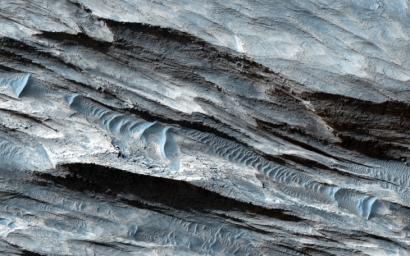
|
Basin in the West Candor Chasma Layered Deposits
- Click the image above for a larger view
- Full-Res JPEG (2880 x 1800) (877.5 kB)
- Full-Res TIFF (2880 x 1800) (15.6 MB)
Caption:
This basin in Ceti Mensa exposes concentric rings in the sedimentary layers. Dark sand ripples and textures in the bedrock suggesting wind scouring are also apparent.
Wind is a powerful, erosive force, transporting fine-grain sediments that can shape topography and expose darker material underneath the surface. One such feature of wind-scour on Mars is in Gale Crater, where scouring has created a stair-step pattern .
Background Info:
HiRISE is one of six instruments on NASA's Mars Reconnaissance Orbiter. The University of Arizona, Tucson, operates the orbiter's HiRISE camera, which was built by Ball Aerospace & Technologies Corp., Boulder, Colo. NASA's Jet Propulsion Laboratory, a division of the California Institute of Technology in Pasadena, manages the Mars Reconnaissance Orbiter Project for the NASA Science Mission Directorate, Washington.
Cataloging Keywords:
| Name | Value | Additional Values |
|---|---|---|
| Target | Mars | |
| System | ||
| Target Type | Planet | |
| Mission | Mars Reconnaissance Orbiter (MRO) | |
| Instrument Host | Mars Reconnaissance Orbiter | |
| Host Type | Orbiter | |
| Instrument | High Resolution Imaging Science Experiment (HiRISE) | |
| Detector | ||
| Extra Keywords | Color, Crater | |
| Acquisition Date | ||
| Release Date | 2013-08-21 | |
| Date in Caption | ||
| Image Credit | NASA/JPL-Caltech/Univ. of Arizona | |
| Source | photojournal.jpl.nasa.gov/catalog/PIA17643 | |
| Identifier | PIA17643 | |
